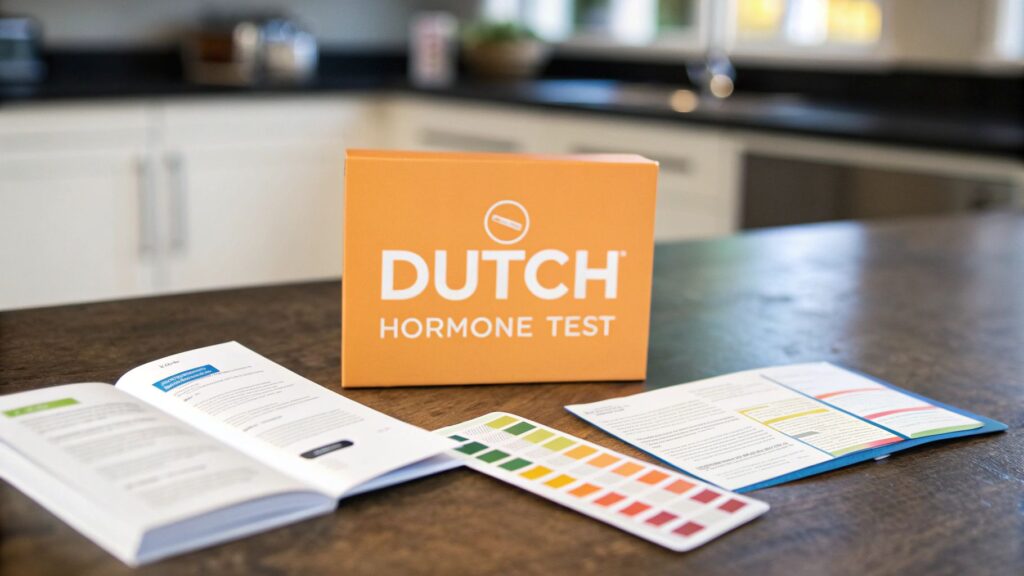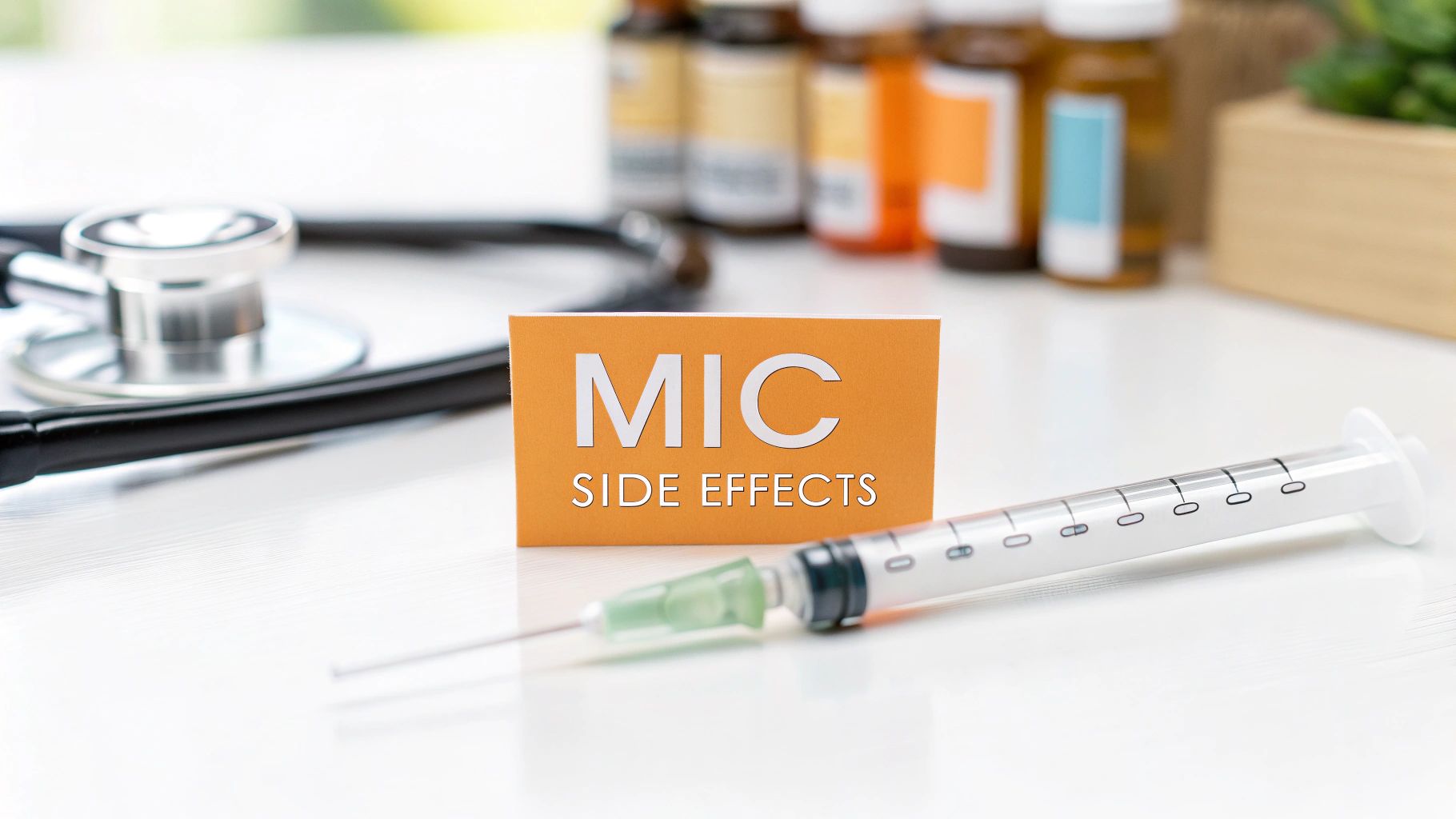A Guide to the DUTCH Hormone Test

The DUTCH hormone test is a game-changer. It's a comprehensive, at-home lab test that gives you the full story on your hormones and their metabolites using simple dried urine samples. Unlike a single blood draw, it provides a dynamic view of your hormonal health throughout the day, offering far deeper insights into complex health issues.
What Is a DUTCH Hormone Test, Anyway?
Imagine trying to understand a full day's story from a single photograph. That’s what a standard blood test for hormones often gives you—a brief, static snapshot in time. The DUTCH test, on the other hand, is like watching the entire short film of your day. It captures the highs, lows, and crucial plot points that a single image would completely miss.
DUTCH stands for Dried Urine Test for Comprehensive Hormones. It’s a modern, elegant method that paints a big-picture view of your hormonal landscape. Using simple, non-invasive dried urine samples collected at four key moments over 24 hours, it measures not just your hormone levels but, crucially, their metabolites too.
More Than Just Levels—It Shows How Your Body Works
Think of your hormones—like cortisol, estrogen, and testosterone—as the fuel in your body’s engine. A standard test might tell you how much fuel is in the tank at one specific moment. The DUTCH test goes much further by analyzing the "exhaust," or metabolites. These metabolites reveal how your body is actually using that hormonal fuel.
This distinction is absolutely critical for getting to the root cause of so many health concerns. The DUTCH test can help uncover the "why" behind imbalances related to:
- Chronic fatigue and burnout
- Persistent mood swings or anxiety
- Sleep disturbances and insomnia
- Fertility challenges and menstrual irregularities
- Symptoms of perimenopause or andropause
By mapping out your daily hormonal fluctuations and metabolic pathways, the DUTCH test provides a far more complete and actionable story. It helps practitioners move beyond guessing games to develop targeted, effective strategies for your health.
Scientifically Validated and Incredibly Convenient
The accuracy of this method isn't just a theory; it's backed by solid science. A key 2019 peer-reviewed study officially validated the DUTCH method, showing that hormone metabolites could be reliably measured from these simple dried urine samples.
This research proved a strong correlation with traditional blood tests and, importantly, showed that the 4-spot collection method effectively captures your total daily hormone output. This makes it a scientifically sound alternative to the cumbersome 24-hour liquid collections of the past. You can easily find the validation studies for the DUTCH method online to see the data for yourself.
This level of detail is especially important when you're considering treatments that influence your body's hormonal systems. For anyone exploring options like bioidentical hormone replacement therapy, having a precise baseline from a DUTCH test is invaluable for creating a plan that is both safe and effective.
How The DUTCH Test Stacks Up Against Other Hormone Tests
Choosing the right hormone test can feel like navigating a maze without a map. Each method offers a different piece of the puzzle, but not all of them give you the complete picture. To really understand what’s going on inside your body, you have to know what each test can—and can’t—tell you. The dutch hormone test stands out because it cleverly combines the strengths of other methods while dodging many of their biggest limitations.
Let’s break down exactly how it compares to the most common alternatives you’ll encounter.
Blood Serum Tests
A blood test is the old standby, the one most doctors start with. It’s excellent for giving you a number—your total hormone levels circulating in your bloodstream at one specific moment in time. The problem is, that "snapshot" approach is also its main weakness.
Your hormone levels, especially a stress hormone like cortisol, are constantly changing throughout the day. A single blood draw in the morning completely misses the daily rhythm of your adrenal function, which could lead to a misdiagnosis for things like fatigue or sleep issues. A blood test is useful, for sure, but it often lacks the narrative depth you need to connect your symptoms to their hormonal root cause.
This image below gives you a quick look at the DUTCH test’s simple at-home collection process, which is specifically designed to capture these crucial daily fluctuations.

As you can see, the convenience of collecting a few dried urine samples is a world away from scheduling a clinic visit for a blood draw.
Saliva And 24-Hour Urine Tests
Saliva testing is another popular and non-invasive option. Its biggest advantage is that it measures “free” hormones—the portion of hormones that are unbound and biologically active. This is valuable information, especially for mapping out cortisol's daily pattern with multiple samples. But where saliva tests fall short is a big deal: they can't measure hormone metabolites, leaving a massive gap in understanding how your body is actually breaking down and getting rid of its hormones.
Then you have the 24-hour liquid urine test. This method is incredibly thorough, capturing your total hormone production and all those important metabolites over a full day. The major downside? It’s a huge pain. Having to collect every single drop of urine for 24 hours in a giant jug is awkward, impractical, and frequently leads to collection errors that can throw off the accuracy of your results.
The perfect test would blend the comprehensive data of a 24-hour urine test with the easy, at-home collection of saliva testing. This is precisely where the DUTCH test comes in.
The DUTCH Advantage: A Clear Comparison
The DUTCH test was designed to bridge the gap between these older methods. By using dried urine samples on filter paper, it makes the collection process as simple as saliva testing while delivering the rich, detailed data you’d get from a full 24-hour urine collection. It’s truly the best of both worlds.
To see how they all measure up, let’s put them side-by-side.
Hormone Test Method Comparison
| Feature | DUTCH Test | Blood (Serum) Test | Saliva Test | 24-Hour Liquid Urine |
|---|---|---|---|---|
| Convenience | Excellent (At-home, simple) | Poor (Clinic visit, needle) | Good (At-home, non-invasive) | Poor (Cumbersome, inconvenient) |
| Metabolites | Yes (Comprehensive view) | No | No | Yes |
| Cortisol Rhythm | Yes (4-5 point curve) | No (Single point) | Yes (4-5 point curve) | No (Averaged total) |
| Overall Insight | Extensive and dynamic | Limited snapshot | Moderate, lacks depth | Comprehensive but static |
Ultimately, the dutch hormone test gives you the full story. It doesn’t just show you a single number; it reveals your hormones’ daily rhythm and how your body metabolizes them, providing a uniquely detailed and actionable roadmap to reclaiming your hormonal health.
Getting Your DUTCH Test Done: A Start-to-Finish Walkthrough
One of the best things about the DUTCH hormone test is how simple and convenient it is. You don’t have to schedule a clinic visit or deal with a complicated medical appointment. Instead, it’s a powerful diagnostic tool you can use entirely from the comfort of your own home, putting deep hormonal insights within everyone’s reach.
The whole process is built around a non-invasive, user-friendly collection method that feels straightforward right out of the box.
Your Simple At-Home Collection Routine
At the core of the DUTCH test is a four-part sample collection designed to map your body's hormonal rhythm over a full day. You’ll collect a small urine sample on a specialized filter paper at four specific times. Capturing this daily rhythm is absolutely essential for understanding how hormones like cortisol rise and fall from morning to night.
The collection schedule is easy to follow:
- Upon Waking: Your first sample is collected the moment you wake up, giving a baseline for your morning cortisol levels.
- Before Lunch: The second sample provides a snapshot of your hormone activity in the middle of the day.
- Before Dinner: This third collection helps track how your hormones are trending as you head into the evening.
- At Bedtime: The final sample reveals your hormone levels right before sleep, which is critical for assessing things like sleep quality.
Each collection is a breeze. You just urinate into a cup, dip the filter paper into the sample, and then let it air dry completely. The kit comes with detailed, foolproof instructions that walk you through every step.
The goal of this four-point collection is to create a dynamic map of your daily hormone patterns. This method provides far more context than a single blood draw, revealing the story of your hormonal health as it unfolds over a typical day.
From Your Home to the Lab
Once all four of your samples have been collected and are bone dry, you just package them into the provided return mailer. The drying process is key—it preserves the hormones on the filter paper, making sure the sample stays stable and accurate on its way to the lab. You simply pop the dried strips in their designated bag, seal the envelope, and mail it back.
After your kit arrives at the lab, it undergoes a highly sophisticated analysis. Scientists use a technique called mass spectrometry to precisely measure the hormones and their metabolites from your dried samples. This technology is incredibly sensitive, allowing for a detailed and accurate breakdown of dozens of different hormonal markers.
This entire start-to-finish experience is designed to be seamless and stress-free. From the simple collection at home to the sophisticated analysis behind the scenes, the DUTCH test process removes barriers, putting comprehensive hormonal data directly into your hands.
How to Read Your DUTCH Test Results
Getting your DUTCH test results back can feel a bit like being handed a complex treasure map. At first glance, the pages of dials, gauges, and pathways tracing your hormones' intricate journey might seem intimidating. But this report is one of the most powerful tools you can have for understanding what’s really going on inside your body.
Don't think of it as just another confusing lab report. See it as your personal hormonal roadmap. It’s designed to show you not just your hormone levels, but the exact routes they take and how efficiently your body is using them. Instead of giving you a single number, it reveals the entire journey—complete with traffic patterns and potential roadblocks. This detailed, big-picture view is what makes the DUTCH test so incredibly insightful.

Navigating the Key Sections
Your DUTCH test report is broken down into several key visual sections, each telling a different part of your hormonal story. Getting to know what each section represents is the first step toward having a truly informed conversation with your healthcare practitioner.
You’ll typically see distinct areas focusing on:
- Sex Hormones and Metabolites: This is where the test maps out how your body processes key hormones like estrogens and androgens (including testosterone). It’s like getting a flowchart of your hormonal factory, showing both production levels and how well the byproducts are being managed.
- Adrenal Hormones: Here, you'll find the famous "adrenal dials" that chart your cortisol and cortisone patterns throughout the day. This graph reveals your stress hormone rhythm from the moment you wake until you go to bed, offering critical clues about fatigue, anxiety, and sleep quality.
- Organic Acids Tests (OATs): Think of these markers as bonus insights. They can shed light on nutrient deficiencies (like B12 and B6), oxidative stress, and even your neurotransmitter levels.
The goal isn't to diagnose yourself, but to get familiar with the landscape of your own body. Knowing these terms helps you ask smarter questions and better understand the recommendations your practitioner makes.
A DUTCH test report is a narrative, not just a set of numbers. It tells the story of how your hormones interact, how your body copes with stress, and where imbalances may be starting.
Preparing for Your Practitioner Discussion
As you look over your report, it’s important to remember this test is one piece of a much larger puzzle. While the dutch hormone test is a valuable tool for functional and integrative practitioners, it is still viewed with some skepticism in conventional medical circles. This is often because large-scale clinical trials proving its value in treatment decisions are still emerging. Because of this, the test is best seen as an advanced tool to be used alongside a thorough clinical assessment by a skilled practitioner. You can discover more insights about this practitioner perspective and see how the test fits into modern healthcare.
When you sit down with your provider, focus on connecting the data on the page to the symptoms you're feeling every day. For instance, if you see a flat cortisol curve in the adrenal section, you can ask, “Could this explain why I hit a wall every afternoon?” Or if you notice high levels of a specific estrogen metabolite, you might ask, “What does this mean for my long-term health, and what steps can we take?”
By approaching your results with curiosity and a basic understanding of what you’re looking at, you shift from being a passive recipient of data into an active participant in your own health journey.
Who Should Consider a DUTCH Test?
The real power of a DUTCH hormone test isn't just about the data it spits out; it's about how that data connects directly to real-life health struggles. This test is for anyone who feels like they’ve hit a wall and needs deeper answers than conventional testing can provide.
If you're dealing with persistent symptoms but can't seem to pinpoint the root cause, this test might just be the key you've been looking for. It shines a light on complex hormonal scenarios, turning vague feelings of "off-ness" into a clear, actionable roadmap. It’s especially helpful for people navigating specific, and often frustrating, health journeys.

Women Navigating Hormonal Transitions
For women, the journey through different life stages brings a cascade of hormonal shifts. A DUTCH test can provide profound clarity when things feel chaotic.
- Perimenopause and Menopause: Symptoms like hot flashes, mood swings, and sleep disruption are common, but the underlying hormonal storm is unique to each person. The DUTCH test maps out exactly how your estrogen and progesterone are fluctuating, giving a clear "why" behind your symptoms and paving the way for targeted support.
- Fertility and Menstrual Issues: If you're struggling with conditions like PCOS, endometriosis, or unexplained infertility, this test can reveal issues like androgen excess and how your body metabolizes those hormones. These are critical clues that can guide a more effective treatment strategy.
- Estrogen Metabolism Concerns: We know that one in eight women will be affected by breast cancer in their lifetime. A DUTCH test can show how your body breaks down estrogen into either protective or potentially harmful metabolites, offering insights that empower you to make proactive health decisions.
By seeing the full picture of your estrogen metabolism, you and your practitioner can make much more informed choices about diet, lifestyle, and potential therapies to support your long-term health and well-being.
Men Experiencing Age-Related Changes
Hormonal decline isn't just a female issue. Men experience a gradual drop in testosterone—a process sometimes called "andropause"—which can start as early as their 30s.
The symptoms of low testosterone are often brushed off as just "getting older," but they can seriously impact your quality of life. Think:
- Chronic fatigue and low energy
- Decreased muscle mass and strength
- Brain fog and reduced focus
- A noticeable drop in libido
The DUTCH test doesn't just give you a single testosterone number. It shows how your body is using and converting it, giving a much clearer, more complete picture of your hormonal health.
Anyone Battling Fatigue and Burnout
If you feel constantly exhausted, stressed out, or can't seem to get a restful night's sleep, your adrenal health is almost certainly part of the puzzle. A standard blood test might show your cortisol levels are "normal," but it completely misses the daily rhythm of your stress hormones. It's a single snapshot of a day-long movie.
The DUTCH test, on the other hand, maps your 24-hour cortisol curve, showing you precisely when your stress hormones are peaking and dipping. This data can finally explain why you feel "wired but tired" at night or why you crash hard every afternoon. Pinpointing this dysregulation is the first step toward rebuilding your energy and resilience. For those with significant imbalances, understanding these patterns is crucial before exploring options like hormone replacement therapy.
Why Advanced Hormone Testing Is More Popular Than Ever
If you're looking for a more detailed picture of your hormonal health, you're not alone. The days of accepting a single lab number as the final word on complex issues like persistent fatigue or mood swings are quickly fading. More and more, people are seeking a deeper understanding of their bodies, driving a major shift toward a more personalized and functional approach to medicine.
This movement is powered by a growing awareness that a basic blood test just can't capture the full story. It might tell you a hormone level at one specific moment in time, but it misses the crucial context of how your body is actually using and metabolizing those hormones throughout the day.
This demand for better, more comprehensive data is showing up in the numbers. The global market for endocrine testing was valued at USD 12.19 billion in 2023 and is projected to skyrocket to USD 21.42 billion by 2030. That’s a massive jump, and it sends a clear message: people want more advanced diagnostic tools. You can read the full research on this market trend to see the data for yourself.
This trend positions the DUTCH hormone test not as some niche product, but as a key solution meeting a widespread need for comprehensive, actionable health information.
This whole evolution in healthcare is about empowerment. It gives both you and your practitioner the ability to move beyond surface-level metrics, using detailed reports to finally connect frustrating symptoms to their underlying hormonal causes and build a wellness plan that’s truly designed for you.
Your Questions About The DUTCH Test Answered
Stepping into advanced diagnostics like the DUTCH hormone test naturally brings up a few practical questions. Getting clear, straightforward answers is the best way to feel confident and prepared. Here, we'll walk through the most common things people ask before ordering their test.
Is the DUTCH Hormone Test Covered by Insurance?
Coverage for this kind of specialized functional test can be a bit of a mixed bag, varying widely between insurance providers and individual plans. To be blunt, many standard policies may not cover the full cost, though some might offer partial reimbursement.
Your best first step is to call your insurance company directly. Ask them specifically about their policy on "specialty dried urine hormone testing" to see what's possible. Usually, you'll pay for the test upfront and then submit a claim yourself using the paperwork your practitioner provides.
How Long Does It Take to Get Results?
Once you’ve collected all your samples and mailed them back to the lab, you can generally expect your results in about 2-3 weeks. This timeframe gives enough room for shipping, the incredibly detailed lab processing, and the final generation of your comprehensive report.
Your healthcare practitioner will almost always receive the results first. From there, they'll schedule a follow-up consultation with you to go over the findings in detail, explaining what every marker means for your health.
Do I Need a Doctor to Order a DUTCH Test?
Yes, in most cases, you'll need a licensed healthcare practitioner to order a DUTCH test for you. The results are incredibly detailed and really require a professional's eye to be interpreted safely and turned into an effective health plan.
Experts like functional medicine doctors, naturopaths, and specially trained nutritionists are the ones who can connect the dots between your results and your symptoms. They are essential for building a personalized strategy, which might include diet, lifestyle changes, or exploring treatments. You can learn more about why practitioner guidance is so vital, especially when considering potential treatment side effects.
Ready to uncover the full story your hormones are telling? Elite Bioscience provides the tools and support you need to take control of your health. Order your advanced diagnostic tests and therapies through our secure platform today. https://elitebioscience.co
QUICK SEARCH
Make an account today to start your journey towards a better and healthier lifestyle.






